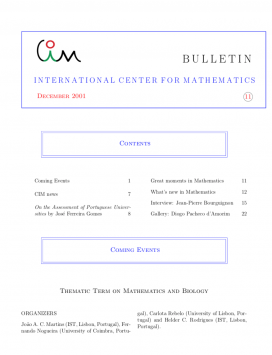Coming Events
1-6
Thematic Term on Mathematics and Biology
CIM News
7
Balaguer Prize awarded to M. Golubitsky and I. Stewart’s monograph
The Ferran Sunyer i Balaguer Prize for 2001 has been awarded by the Institut d’Estudis Catalans to Martin Golubitsky and Ian Stewart for their monograph “The Symmetry Perspective: From Equilibrium to Chaos in Phase Space and Physical Space”. According to the Institut, the Balaguer Prize, with a value of 10 000 Euros, “is awarded each year for a mathematical monograph of an expository nature presenting the latest developments in an active area of mathematics research in which the author has made important contributions.”
On the Assessment of Portuguese Universities
José Ferreira Gomes
8-10
Portugal has been progressively introducing a culture of assessment in Higher education.
The change has been fast and well succeeded. The assessment of university courses started in a very tentative way around 1995 among fears of rejection by the community and a lot of suspicion. This exercise was organized by the CRUP (the Council of Rectors of Portuguese Universities) with delegated powers of the Ministry of Education. The first round was completed with a reasonably high technical quality and its success led to the extension of the process to non-university public Higher Education and to private institutions. This process of as- sessment is designed in a way that attempts to consider all aspects related to contents and the teaching/learning process for each particular undergraduate degree. Research performance was considered only in a very indirect way.
Great Moments in XXth Century Mathematics
Roger W. Carter
11
I have chosen for my great moment the appearance in 1976 of the paper by Deligne and Lusztig ‘Representations of reductive groups over finite fields’.
Geometric Quantum Computation is the topic of a “Perspectives” article in the June 1, 2001 issue of Science. The author, Seth Lloyd, of the MIT Mechanical Engineering Department, explains some recent work in quantum computation. The new research shows how holonomy, in particular the phase changes undergone by a particle moving through a tailored electromagnetic landscape, might be harnessed as the operations of quantum computation. Lloyd describes holonomy “...imagine yourself walking over a gently curving landscape ... you wind up back where you started ... to your surprise you are now facing the opposite direction.” Don’t try this at home, unless you live on a very small asteroid.
Jean-Pierre Bourguignon
F. J. Craveiro de Carvalho
15-21
I am not familiar with the school system in France but from your CV it seems that your first degree was an Engineering one granted by l’École Polytechnique. Is that so? What made you change your mind and realize that you wanted to be a mathematician ? An influential teacher ?
Diogo Pacheco d’Amorim
Dinis Duarte Pestana
Sílvio Filipe Velosa
22-24
Diogo Pacheco d’Amorim, born in Monção in 1888, made his elementary and secondary studies in Monção and Braga, and after that entered the Faculty of Mathematics of the University of Coimbra. Although his original purpose had been to get a degree in military engineering, the invitation of his teachers and some disap- pointment with the army institution led him to change his mind.
